RIDING TWO UP
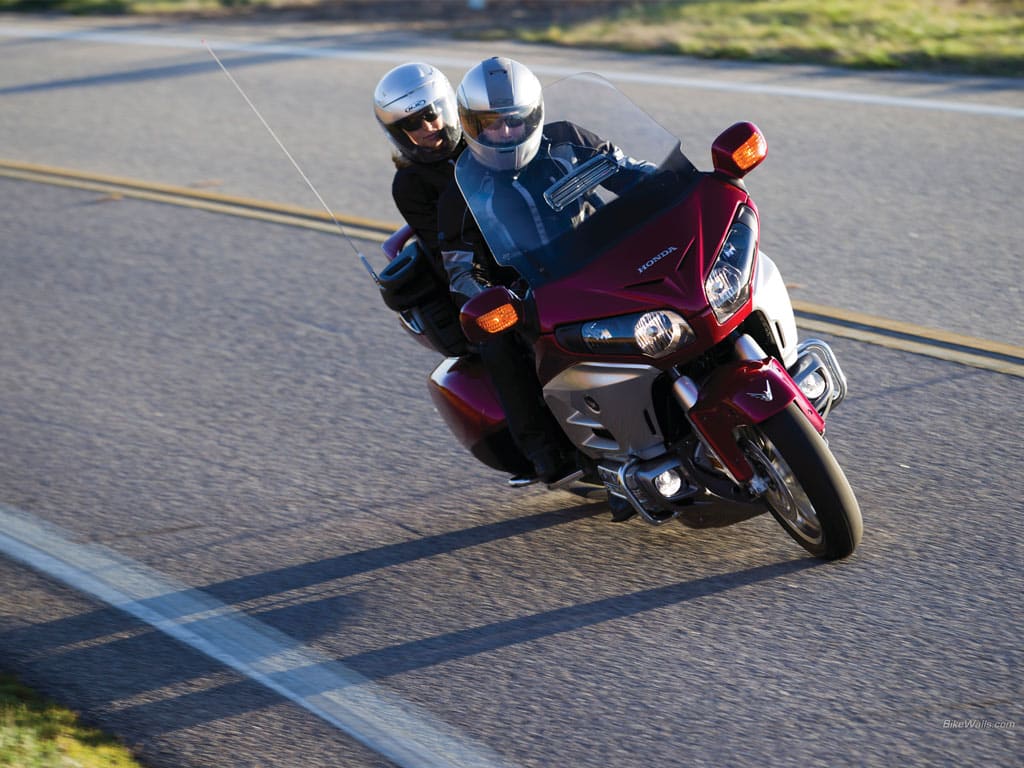
INTRODUCTION
Helmets… check Gloves… check Pegs down… check Passenger… check
You settle into the saddle, followed by the person who will be sitting just a deep breath away from your backside. As the pavement begins to roll under the pegs, you sense that all is right with the world. For many couples, if not most, sharing the ride with that special person is what cruising on two wheels is all about.
Though the short checklist above has worked for millions of couples with no ill effects, I know of one or two rides that ended a promising romance following a pillion’s first ride. But, what causes a nice ride to go south faster than shifting from first to second? What can a rider do to avoid an ugly two up experience? These are good questions and of course everyone has an opinion. So, based upon my own personal experience, here’s my two cents.
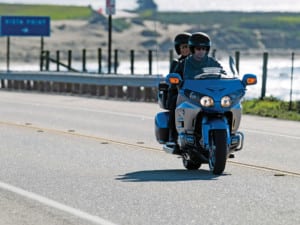
ONE BIKE, TWO MINDS
Jumping on the bike and picking a point on the compass works fine for solo rides. But, when you add another person to the ride, that should cause you to pause for more than a moment and think through what the ride is all about. In other words, you should plan the trip if you are to have the best ride possible.
In this article, we will refer to the guy holding the handlebars as the pillion and the passenger as the pillion.
Most pilots recognize that a second person is not baggage. That said, a second person along for the ride means that both know what the other person expects during the journey, not just upon arriving at the destination. Planning a ride doesn’t mean that you are rigidly locked into a route, but it does mean that you and your pillion agree on a destination, a reasonably flexible time frame, rest stops, fuel stops and possible points of interest that you would like to visit along the route. Not everyone thinks the same with two up riding, but in my experience, planning out a ride can make the journey a bit smoother.
Before you sit down at the kitchen table with a pencil in hand, the pillion and especially the pilot need to recognize that both travelers have an equal say in planning out the ride. Just because the pilot is one holding the handlebars, doesn’t make him the all knowing and all seeing travel guide. When a pilot has invited a person along for a first ride, the big goal of the trip should be that both will still be enjoying each other’s company at the end of the ride. Taking the time to plan out a ride is one way to help a new rider to enjoy the experience.
There are three parts to planning a ride. The first part is the human factor. The second is planning route and the third is planning for the unexpected.
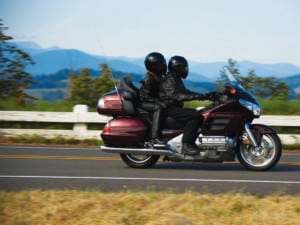
THE HUMAN FACTOR
The main human factor is talking with the pillion before ever sitting on the saddle. As I mentioned earlier, the pillion is turning over all control of the ride to the pilot. So she is trusting him 110% to make the right decisions for keeping them both vertical and at ease along the way. When a pilot treats the pillion with a paternal attitude, then he is treating her like so much extra baggage and no one likes to be treated like baggage. So have a conversation and allow the pillion to voice her interests, needs and concerns. A pre-ride discussion with a new pillion should encompass a review of the following:
1) Destination – where you will land at the end of the ride
2) Route you will follow
3) Rest stops where you intend to stretch your legs
4) Explain to the pillion the importance for imitating the pilot in leans.
5) Review hand signals or intercom communication
6) Avoid bumping helmets when decelerating
7) Explain to the pillion that she should wait until you are seated, kickstand is up and you give her the nod to step on the peg.
8) Once the pillion is seated, ask her not to remove her boots from the pegs until the motorcycle is completely stopped and engine is off.
9) The rider should place the new rider’s hands around his waist. Not on the shoulders and NOT the seat strap
As the new pillion gains experience, the pre-ride discussions will become quicker. But I am going to encourage you not to eliminate pre-ride discussions regardless of the miles traveled together.

THE ROUTE
Depending on the destination, how far and how many miles will you and the pillion be willing to ride in one day trip or over several days. You may be comfortable pounding out the miles, but your pillion may have a more sensitive bottom side. A ride longer than both are comfortable only creates fatigue and a first or second time ride can lose its enjoyment pretty quick. So, together, look at a map and find points of interest both of you will enjoy along the route. Google makes it easy to find countless points of interest that neither you or pillion may have heard of or thought to visit.
The pilot and the pillion will also need to agree on how many miles between rest stops. This isn’t chiseled in stone and you should be reasonably flexible with each other. This can be determined upon the type of machine that you will ride, the road you will travel, the capacity of a person’s bladder or the weather. For example, an older couple riding a 1989 Harley Electra Glide may motivate these travelers to plan more frequent and longer rest stops than would a smooth and quiet bike engineered for touring and ridden by a younger couple. If your bike has a hard seat, this will make the ride quickly uncomfortable for any passenger who will frequently shift around to remain comfortable. If you know the pillions seat has not been broken in, you may want to purchase a soft gel or air cushion for the passenger for a more enjoyable trip.
Fuel stops shouldn’t determine your choice of rest stops. There is nothing relaxing or particularly enjoyable about stretching your legs walking around a gas station minimart. So estimate your average mileage and then mark the location of gas stops along the way and save the rest stop for a more appealing location.
My wife and I have personally found that 45 minutes traveling in the saddle followed by ten to twenty minute rest stops has kept our rides pretty enjoyable. Each couple can pick the ratio of ride time to rest time for themselves, but both travelers need to agree and to be flexible if something unexpectedly catches the other’s interest… shopping, eating, photographs or a quick nap on the grass. One last point, both the rider and the pillion need to remain hydrated and take in a few calories at stops. This will help to ward off fatigue and irritation commonly experienced on long rides.
Both travelers need to realize that when two minds ride the same bike, the journey becomes as important or more so than the destination even if the ride is only one tanks’ distance.
COMMUNICATIONS
Unless a rider and pillion are connected with electronic communicators, questions and answers on the road tend to be limited to one or two words. So, it’s a nice idea to practice a few hand signals. The important ones such as bathroom stop can be a quick squeeze to the inner thigh of the pilot. Water can be a cupped hand, leg cramp can be a clenched fist and slow down can be a tap to the shoulder. If the passenger needs to stop immediately, create a signal you both will understand. You get the idea that sign language can save a bit of frustration.
Wired and Bluetooth communication is a nice way for couples to enjoy trips together. My wife and I have been using the Scala Q2 for a couple of years with no technical hiccups so far. We point out scenery to each other and have the same conversations we normally have in a car. And if we become tire of talking with each other, one of simply turns off the intercom. Not a feat so easily done in the car. One caveat… conversations can distract the pilot while riding especially when the pillion points out a site that takes the pilot’s eyes off the road. This is especially noticeable in the twisties, so let the pillion know when silence is golden.

PLANNING FOR THE UNEXPECTED
The pilot is responsible for all the pre-ride maintenance of his machine. Inspection of the tires, correct tire pressure for the extra weight, adding preload tension to the shocks, oil, fluids, illumination and so forth. When carrying a second body, don’t assume everything is hunky dory… check it.
Planning your trip also means carrying the right tools for the mechanical problems that can happen along the way. The right tools are defined as the tools you normally use for maintenance and repairs on your bike at home. That way you know that the tools you carry will work the same on the road. Definitely do not depend on the tools that are provided by the bike manufacturer. For many new models, you might as well just throw those sad excuses for tools in the trash. You invested a lot money in purchasing your machine.. so invest a bit more in quality tools you can depend upon.
Even if you don’t do your own maintenance and repairs and your motorcycle does develop a problem, a good samaritan who knows how to use those tools may come along and get you back on the road again. Good tools only need to be used once to pay for themselves. Also include a small roll of duct tape, electrical tap, zip ties, both a hand held and head mounted LED flashlight, extra batteries, various fuses, sharp knife, nitril gloves, clear safety goggles, disposable wet wipes, a flat tire repair kit and a small first aid kit. Three folding reflectors are helpful if a mechanical problem were to happen night.
The pilot should check the weather forecasts as well as highway construction or hazards such as fresh sprayed oil or tar on road. The internet makes those potential issues a simple process to anticipate and bypass if necessary. If cold temperatures or rain are forecast along the route, the wet and cold weather gear should be easily accessible if you anticipate riding through it. Dressing in layers is important for both the rider and pillion’s comfort and safety. Knowing where your gear is packed will keep you from rummaging through the luggage or saddlebags when the thermometer plunges.
As simple as this sounds, have cash and/or a primary credit card in an outside zippered pocket of your jacket so you can avoid searching through 7 pockets of your jacket for your wallet. If you ride past a toll booth or just want to gas up, it makes it a bit quicker get it done.
GPS can make traveling a bit easier, but don’t bet your life on them. When it comes to electronics, I live by Murphy’s Law. If electronics can break or get me lost, they will. For overnight or new routes, I always keep a hardcopy of the rout filed away in the pack. I also use the hardcopy to mark the locations and telephone numbers of dealerships or repair shops along the route. The same applies for tows if your machine shuts down.
The odds are against you ever needing to pull out this information, but if the Murphy does happen to show up, it’s easier to know with certainty where the nearest dealership assistance is available rather than trying to find it on your cell phone in the middle of nowhere. In regards to cell phones. Make sure you and the Pillion both have one and it’s a good idea to turn at least one of them off to have a fresh battery just in case one runs out of juice.
If your machine has hard mounted luggage and saddle bags, take a moment to demonstrate to the new passenger how the latch works. Also, walk around the bike with the new pillion and point out the hot parts they will want to avoid touching or stepping on.
As laborious as the pre-ride conversation may sound, don’t underestimate their value. Also, before you are ready to mount up, give her a hug or kiss before getting on the bike. That little gesture can last the entire day and into the evening.
GEAR
As an MSF rider coach, I teach student riders to dress for the fall and not the weather. But, many riders don’t always get the memo. If your pillion doesn’t want to gear up, then it’s the pilots call. Explain to the new pillion that gear is the only thing that will separate her from the asphalt at speed and that road rash and the subsequent wound cleaning hurts more than anything she will ever experience. Dressing for the fall means a DOT helmet, abrasion resistant textile or leather jacket, chaps or heavy denim pants, good quality over the ankle boots and full finger gloves.
In regards to the boots, be sure the pillion has boots that are broken in and comfortable for walking around. You are not always going to be sitting on the bike. And fashion leather does not provide protection from hot exhaust or asphalt. Not to push a point, but if pillion ends up sliding along the asphalt at 50 or 60 mph, how bad are you going to feel as the ER nurse is scrubbing the road rash from her wounds. Protecting the pillion from injury is part of the pilots responsibility.
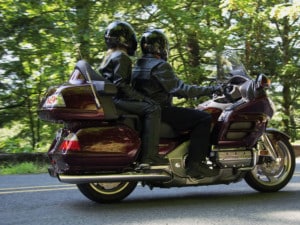
THE DYNAMICS OF ADDED WEIGHT
As all riders intuitively understand, controlling a motorcycle is more complex than driving a four wheel vehicle. And the complexity increases when the dynamics of the motorcycle changes. Motorcycles are engineered for the rear tire to carry approximately 60% of the total weight of a motorcycle at constant speed, while the front wheel 40%. This weight ratio front to rear noticeably changes under acceleration and deceleration. With a single rider, sitting at the center of gravity, the impact upon control is not generally significant.
Now consider what happens to the weight ratio front to rear when you add a second person and luggage behind the normal center of gravity. A simple way to counter a shift backward of the center of gravity is to increase the preload tension of the rear shocks. Increasing the preload tension, will counter the extra weight for more normal handling and stability on the road.
The second component for maintaining optimum suspension is the tire’s air pressure. The normal operating tire pressure for a single body is not adequate to bear the load of an extra body, so this requires the rider to up the tire pressure for both the front and rear, before riding the road. The number one reason for sudden tire failure are underinflated tires. So check your owner’s manual for the proper tire pressure when carrying added weight
If after increasing the air pressure and preload tension and your bike’s handling continues to be light at the front wheel, you may consider replacing your OEM shocks with heavy duty aftermarket. This can make a real difference in the comfort and handling while on a ride.
Riders need to never forget that the stability and control of a motorcycle is altered with extra weight sitting over the rear wheel and must adapt to the different handling and braking characteristics of their bike.
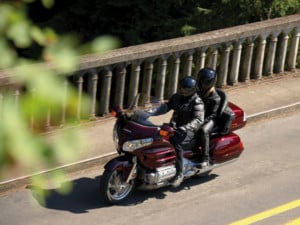
RIDER SKILL
Contrary to popular opinion, riding time and riding skills are not synonymous. Riders can often ride adequately by themselves, but come up dangerously short with a pillion sitting over the rear wheel. Before you take someone else on a ride, you need to honestly ask yourself: can you skillfully handle accelerating, decelerating, swerving, tight turns and emergency quick stops when carrying the extra weight of a person behind you? Do you know how far it will take your bike to come to a complete stop with the extra weight at different speeds. Can you accelerate without leaving your pillion sitting on the asphalt watching you ride off toward the horizon?
What if the pillion doesn’t lean as you expect when you find yourself entering an unexpected decreasing radius turn. Practiced and prepared for sudden surprises that do happen on the road is what distinguishes the proficiently skilled riders from our adequately prepared brethren. 99% of the time, you will not have any issues when your are enjoying a ride with that special person, but it only takes once for a nice day to suddenly turn ugly. If you are not skilled enough to handle unexpected tight turns with scraping pegs or sudden emergencies that happen when riding by yourself, what makes you think you will be able to with a pillion behind you.
If you are not comfortable making a slow tight U-turn with a passenger or know how far your bike can lean over with the extra weight of a passenger, you need to practice skills recommended by experts like David Hough and/or attend courses from organizations like Street Masters. You may travel 100,000 miles without an incident, but then again you may not. Riding skills are not something you leave to dumb luck. Practice your skills until you can do each in your sleep. One last point, a rider needs to practice their skills with a pillion sitting on the back so they both will know what to expect and how to handle the demands when on the road. It should be self evident that when practicing your skills with a pillion, that you start slow and large and then tighten the techniques. This particularly important when rapidly decelerating from faster speeds. So whether you are riding solo or with a pillion, your skills should allow you react intuitively and correctly.
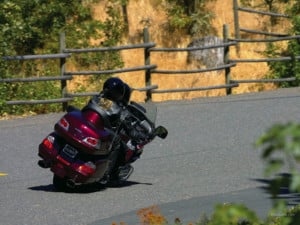
IS THE PILLION ENJOYING HERSELF
At rest stops, ask your passenger if she is enjoying herself. Don’t just accept yes and no answers. Ask specifically if there is something you can do to make the ride more enjoyable. For example, if the pillion keeps banging her helmet against the back of yours as you decelerate, then maybe it’s a good time to discuss why that is happening. Is she comfortable with the speed or lean angles in curves. After a few rides, you will know what your passenger enjoys and what she prefers you avoid.
THE END OF THE RIDE
Whether the ride was just for the day or for a couple of days, take a few minutes to debrief the ride with a new pillion. Don’t just ask if they enjoyed themselves, but go over the days’ experience. What she saw, enjoyed and what she would do differently next time. You may be tired, but the pillion will be as tired from simply sitting still. If you are still romantic at the end of the ride, some fresh cut fruit and a drink makes for an easy revive. If she is not use to wearing a helmet and boots, offer a massage to the neck, back and feet. She is likely to reciprocate which after all is what sharing the day is all about. Putting the finishing touches on a nice ride will definitely improve the odds that the next ride will be at least equally enjoyable.
